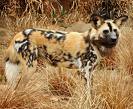African Wild Dogs
// Anatomy and reproduction

The scientific name “Lycaon pictus” is derived from the Greek for “wolf” and the Latin for “painted”. It is the only canid species to lack dewclaws on the forelimbs.
Name controversy
A controversy began in the late 1990s when conservationists working to protect lycaon pictus said that their most common name, “African Wild Dog”, was a source of confusion and prejudice. Conservationist Greg Rasmussen is one of the founders of the Painted Hunting Dog Research Project. He advocates using the name “painted hunting dog
Adults y weight: 17-36 kilograms (37-79 pounds
Height: A tall, lean animal, it stands about 30 inches (75 cm) at the shoulder, with a head and body length averaging about 40 inches (100 cm) and a tail of 12 to 18 inches (30-45 cm).
With a total of 42 teeth, the premolars are relatively large compared with those of other canids, allowing it to consume a large quantity of bone, much like hyenas A study established that the African Wild Dog had a Bite Force Quotient of 142, the highest of any extant mammal of the order Carnivora The BFQ is essentially the strength of bite as measured against the animal’s mass.

The African Wild Dog reproduces at any time of year, although mating peaks between March and June during the second half of the rainy season. Litters can contain 2-19 pups, though 10 is the most usual number. The time between births is usually 12–14 months, though it can also be as short as 6 months if all of the previous young die. The typical gestation period is approximately 70 days Pups are usually born in an abandoned den dug by other animals Weaning takes place at about 10 weeks. After 3 months, the den is abandoned and the pups begin to run with the pack. At the age of 8-11 months they can kill small prey, but they are not proficient until about 12-14 months, at which time they can fend for themselves. Pups reach sexual maturity at the age of 12-18 months.
Social Structure
They have a submission based hierarchy, instead of a dominance based one. Submission and nonaggression is emphasized heavily, even over food they will beg energetically instead of fight. This is likely because of their manner of raising huge litters of dependant pups, so if one individual is injured the entire pack would not be able to provide as much.
Hunting & Diet
The African Wild Dog hunts in packs. Like most members of the dog family it pursues its prey in a long, open chase. Nearly 80% of all hunts end in a kill. Members of a pack vocalize to help coordinate their movements. Its voice is characterized by an unusual chirping or squeaking sound, similar to a bird.

After a successful hunt, hunters regurgitate meat for those that remained at the den during the hunt, such as the dominant female and the pups. They will also feed other pack members, such as the sick, injured, or very old that cannot keep up.
The African Wild Dog’s main prey varies among populations but always centers around medium-sized ungulates, such as the Impala. While the vast majority of its diet is made up of mammal prey, it sometimes hunts large birds, especially Ostriches.
A few packs will also include large animals in their prey, such as wild beasts and zebras. Hunting larger prey requires a closely coordinated attack, beginning with a rapid charge to stampede the herd. One African Wild Dog then grabs the victim’s tail, while anotherattacks the upper lip, and the remainder disembowel the animal while it is immobilised. This behaviour is also used on other large dangerous prey, such as the warthog, the African Buffalo, giraffe calves, and large antelope—even the one-ton Giant Eland. The dogs often eat their prey while it is still alive. This disemboweling was a reason to regard the African Wild Dog as repulsive, but recent studies have shown that prey of the African Wild Dog die more quickly than prey of the lion and the leopard, which kill their prey by grabbing the throat and suffocating the animal.
Distribution and threats
The home range of packs varies enormously, depending on the size of the pack and the nature of the terrain. Their preferred habitat is deciduous forests because of large prey herd size, lack of competition from other carnivores, and better sites for denning.[12] In the Serengeti, the average range has been estimated at 1,500 square kilometres (580 square miles), although individual ranges overlap extensively.[8]
The African Wild Dog is endangered by habitat loss and hunting. It uses very large territories (and so can persist only in large wildlife protected areas), and it is strongly affected by competition with larger carnivores that rely on the same prey base, particularly the lion and the Spotted Hyena. Lions often will kill as many wild dogs as they can but do not eat them. It is also killed by livestock herders and game hunters, though it is typically no more (perhaps less) persecuted than other carnivores that pose more threat to livestock.